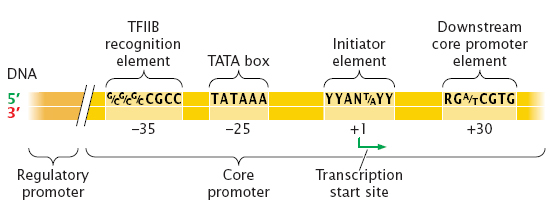Cards In This Set
| Front | Back |
|
(Transcription)3 types of RNApol 1. 2. 3.
|
1. RNApol I- cellular pre-mRNA2. RNApol II- transcript proteins coding gene and mRNA3. RNApolIII- transcribe tRNA
|
|
(Transcription)Steps of RNA synthesis1.2.3.4.
|
1. PolII binds to promoter and begins initiation2. Elongates by adding NTP and creating a 5' nascent RNA3. Once processivity is initiated, full transcription gene occurs4. Termination occurs by RNApol falling off
|
|
(Transcription)Initiation :1. ___ and ____ factors mediate this process2. _____ (__) is recognized by RNApolII on closed initiation complex3. ______ is opened and an abortive transcript is created by RNApol falling off4. ____ bind back on the initial transcribing complex and creates a nascent RNA.
|
1. viral and cellular factors2. Core promoter (TATA and +1)3. Initiation complex4. RNApol I
|
|
(Transcription)Draw PolII promoter structure
|
 1 |
|
(Transcription)PolII promoter structure:1. local regulatory sequence-2. HIV promoter/enhancer-3. viral enhancers
|
1. use specific cellular proteins that bind to help with transcription2. use cellular proteins that recognize this region and their availability in cells determine permissively3. enhance transcription of very fist genes transcribed i.e enhancer-binding proteins bridge DNA to initiate transcription
|
|
(Transcription factors)1. 2.3.4.5.
|
1. contain regions that specify binding to each other, DNA sites and cellular transcription2. Viral transcription factors are configured the same ways as cellular transcription factors3. DNA binding is specific protein-protein interaction4. cellular transcription factors is often not sufficient, need viral transcription factors
|
|
(gene expression assay)Methods to assay gene expression:1. Transient transfection assay- a. b. c.
|
A. a plasmid encoding a promoter linked to a reporter gene are transfected along with plasmid expressing regulatory proteinsb. the reported gene expresses on easily assayed for in-vitroc. allow for the examination of mutated promoter or regulatory protein in a controlled way
|
|
(gene expression assay)In-vitro transcription:1. In vitro transcription- a.
|
A. reconstituted cellular transcription with purified transcription factors in a tube (with or without viral regulatory proteins present or with altered promoter/templates
|
|
(gene expression assay)Methods to assay gene expression:1. Direct measurement of viral mRNA synthesis- a. b. c. d. e.
|
A. northern blotb. RT-pcrc. primer extensiond. nuclear run-one. microarray analysis
|
|
(protein-DNA interaction)Measurement:1. In-vitro2. In-vivo
|
1. gel shift and DNAse footprinting2. ChiP (chromatin Immunoprecipitation
|
|
(transcription)4 Modes of transcription of DNA viruses:1. Viral system
|
1. Pox virus: very large and replicates in cytoplasm; contains own unique regulatory signals in promoter;transcription is initiated on the virion structure before complete uncoating and mediated by vRNApol
|
|
(transcription)4 Modes of transcription of DNA viruses:2. Transcription with no viral factors a. factors that influence
|
Retroviruses: integrates into cellular genome and do not express viral regulatory proteins.
Lentiviruses: "DO" express regulatory proteins because it is treated like any cellular gene when transcribed. A. 1. complicated promoter/enhancer region (contains many binding sites for cellular factors)2. availability of factors in cell3. physical state of chromatin in the integration region |
|
(transcription)4 Modes of transcription of DNA viruses:3. Cascade regulation
|
Most viruses are expressed in a cascade effect. First genes expressed are cellular promoters that have complicated promoter enhancer regions. Proteins products of these genes are regulatory proteins that activates transcription of alter genes. DNA replication to increase number of templates or change physical state of template to activate late viral genes.
|
|
(transcription)4 Modes of transcription of DNA viruses:4. Signal transduction-
|
Some viruses induce cellular pathways by specific interaction with viral surface proteins with receptors on cell surface. This activates kinase cascade inside cell resulting in altered activity or abundance of cellular transcription factors. Then activates vgene transcription.
|
|
( transcription)HIV transcription 2 steps:1. HIV enhancer2. TAT a. b.
|
1. activity is dependent on availability of cellular proteins. Reason why HIV grows in activated T cells and monocytes lineage cells. (NF-kb)
2. increase transcription from LTR creating positive regulatory loop. a. binds to structure at 5'end of nascent RNA called TAR b. has modular structure like many transcription factors. |



